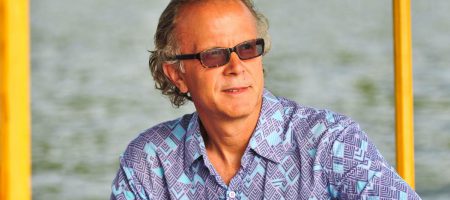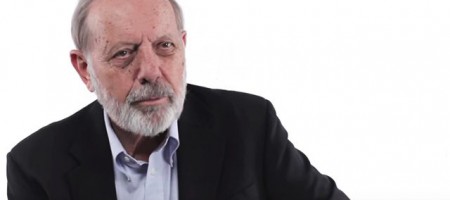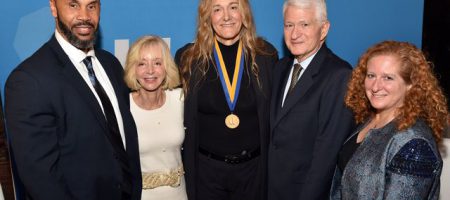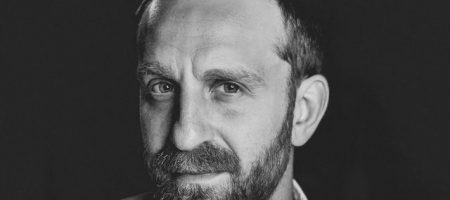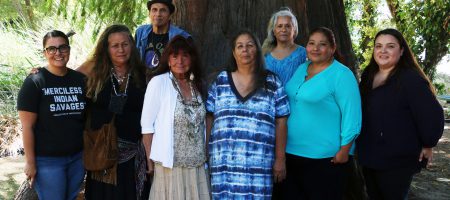Disabled dancers learn to redefine the aesthetics of movement at UCLA

Harmanie Taylor, left, and Vanessa Cruz perform a duet during the Dancing Disability Lab at UCLA. Photo: Reed Hutchinson/UCLA
As the 10 dancers moved across the studio floor in Kaufman Hall, their instructor closely watched how each dancer’s body movements transitioned from one to the next.
Victoria Marks, associate dean of the UCLA School of the Arts and Architecture and professor of choreography, offered encouragement and challenged the dancers to pay closer attention to the way they could shape space both individually and in pairs. Two dancers in wheelchairs faced each other, raising their arms in intricate patterns. Others incorporated crutches or a chair into their actions.
“You are a mover and a maker. You can make us see things,” Marks said to the group, her voice the only sound in the studio as the dancers worked without music. “You have that power, not just in what you’re doing but how you’re doing it.”
The dancers, hailing from around the world, came together for a week in June for UCLA’s Dancing Disability Lab, which was hosted by world arts and cultures/dance and the disability studies minor. They spent their time discussing disability activism and performance, developing their movement skills, creating choreography and exploring how dance can transform and challenge ideas about the body and personhood.
The UCLA Disability Inclusion Lab is a cross-disciplinary initiative designed to reframe cultural understanding and practices around the concept of disability through academic courses and community engagement. Each lab will build and strengthen networks of faculty, staff, undergraduate and graduate students, and community leaders to transform the discourse and awareness surrounding disability. The Dancing Disability Lab was UCLA’s second such project following the Autism Media Lab in the spring.
“I felt from the conception that UCLA was in a position to do something very different from what dance companies across the country are doing for dancers with disabilities,” Marks said. “Because we have a disability studies minor and a dance major, I thought UCLA could combine those resources, making dances and also talking about how what they create engages and changes ideas about disability.”
Each day included seminars on the history of disabled dance and performance, which included watching clips of dance and performance art made by disabled artists and discussions on topics such as access and the use of mobility aids in dance. In one discussion, the dancers and instructors debated whether mobility aids like wheelchairs and crutches could be considered “costumes” (while some supported the idea, others were staunchly opposed).
After the daily seminar, the dancers attended workshops on movement development and choreography. They practiced breathing techniques and explored how their experiences inform their dancing.
Mel Chua, a postdoc in biomedical engineering at Georgia Tech, said she was hesitant to apply for the program because she assumed that her previous dance training (through classes and a contemporary dance company as an undergraduate) wasn’t advanced enough. But Chua came to realize that she only felt unqualified precisely because, as a deaf person, she hasn’t ever had access to dance training like what she experienced at UCLA.
American Sign Language interpreters provided for her throughout the week enabled Chua to engage in spoken, scholarly discussions about dance for the first time, she said.
“I’ve mostly followed dance classes in the past through sight, just watching and copying, but I don’t know the language for dancing since I don’t know how people talk about dancing in English,” Chua said. “Having access to the rhetoric of dance, the way we talk about dance in English — the terminology — in discussion for the first time was amazing because I got to be part of dancers discussing dance, and that’s something I never get to do.”
Another first for Chua and many other dancers was getting to dance with a group of exclusively disabled dance artists. Instead of being the only disabled person in the class, feeling pigeonholed by their disability or having to translate choreography designed for non-disabled dancers, they were united in how they each expanded dancing conventions, Chua said.

Instructor Alice Sheppard, left, performs a piece with the Dancing Disability Lab participants at the public showcase. Photo: Reed Hutchinson/UCLA
Vanessa Cruz, a dance major at Cal State Long Beach who has arthrogryposis (a condition in which the joints are fixed or their movement is restricted) and scoliosis, said she has only ever trained with non-disabled dancers and is accustomed to figuring out how to fit into an art form that caters to people without disabilities, which can be lonely.
Being in a dance workshop where everyone had a disability was empowering and eye-opening.
“It made me feel like I have a voice in this crazy world,” Cruz said. “It was the first time I felt like I belonged anywhere.”
Cruz and Chua both said they are not looking to inspire others or receive sympathy for the challenges they face. Although the idea of inclusion often focuses on bringing disabled and non-disabled people together, Chua believes it’s important for disabled people to have spaces that are just their own. Dancing Disability was exactly what she and her fellow participants needed to advance the field of dance and disability.
“It’s only when we figure out our own maturation of our own practice that we can come out from that place of having our own disabled practice and engage with yours,” Chua said. “There is something that abled people cannot give us, and they don’t need to understand or see what it is, but they need to trust that something is there and that it is important and they should support us having it, even if they never see it or perceive themselves as benefiting from it or learning from it.”
For Cruz, the lab gave disabled artists a chance to be heard and seen differently than what some might be accustomed to — a necessary step in ensuring that non-disabled people will be allies who provide ongoing support for equal access and inclusion.
“People need to know we exist. Dance is the perfect platform to allow our humanity to come through,” Cruz said. “People are either inspired by me or they feel sorry for me because that’s how the media has shaped our identity, but dance can change that.”
Dancing Disability was co-taught by Marks, Rosemarie Garland-Thomson, professor of English and bioethics at Emory University and co-director of the Emory College Disability Studies Initiative, and Alice Sheppard, a disabled dancer and choreographer. The week concluded with a public showcase at Kaufman Hall’s black box theater on June 28.
Marks said the lab showed her how much disabled dancers have to offer to an ever-changing exploration of what dance is and can be.
“There was a sense of full-bodied moving and a ton of imagination — the wit, intelligence and signature of each of the artists,” Marks said. “These artists have so much to offer all of us in terms of opening ourselves to what it means to be human and to be joyous and witty and funny and live life in all the complexities that life offers.”
She also recognized the need for disabled people to be leaders in discussions about inclusion and equal access, which is what the Dancing Disability Lab was designed to facilitate.
“UCLA has always been at the forefront of social justice movements and has recognized the need to address diversity, equity and inclusion, and so this lab is part of what UCLA continues to do,” Marks said. “It’s a tremendous contribution to the field of dance, and if dance represents people and our values and ideas, then it becomes part of that larger civic conversation about who we are.”
This article originally appeared in the UCLA Newsroom.


